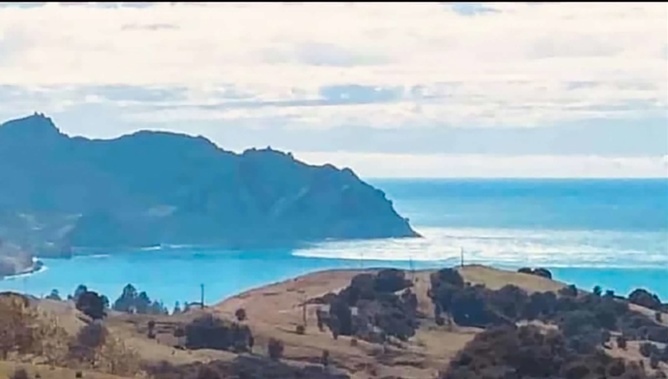
TSUNAMI WARNING LATEST
* Swarm of earthquakes in Pacific - including magnitude 8.1 quake in Kermadec Islands at 8.28am (NZT) - spark Civil Defence warnings.
* Tsunami warning for large parts of North Island coast - people near coast from the Bay of Islands to Whangārei, from Matata to Tolaga Bay, Great Barrier Island, and west coast of the North Island from Cape Reinga to Ahipara told to move immediately.
* There are two different types of tsunami threat. Most of the country is under a beach and marine threat. The parts where evacuations are taking place are under a land and marine threat.
* Evacuation orders "not done lightly" and on basis of watching tsunamis in Indonensia and Japan, official says. "We want people to take this seriously."
* 8.1 earthquake followed 7.4 shake at 6.41am and 7.1 quake off North Island coast at 2.27am.
* Listen live to Newstalk ZB for the latest below:
Hundreds of workers, students and residents are fleeing to higher ground after a third, massive Pacific earthquake this morning - and a tsunami threat that affects much of the Northland, Bay of Plenty and East Coast coastlines.
Residents have been told to move immediately to higher ground after the magnitude 8.1 earthquake struck off the Kermadec Islands, 1000km northeast of New Zealand, at 8.28am (NZT).
There is gridlock in cities such as Whangarei and on other roads around the affected regions.
STORY CONTINUES UNDER LIVEBLOG
"People near coast from the Bay of Islands to Whangarei, from Matata to Tolaga Bay, and Great Barrier Island must move immediately to nearest high ground, out of all tsunami evacuation zones, or as far inland as possible," the National Emergency Management Agency alerted at 8.45am.
"People near coast from the Bay of Islands to Whangarei, from Matata to Tolaga Bay, and Great Barrier Island must move immediately to nearest high ground, out of all tsunami evacuation zones, or as far inland as possible," the National Emergency Management Agency alerted at 8.45am.
The National Emergency Management Authority said residents must evacuate these areas even if they did not feel the earthquake. "DO NOT WAIT. A damaging tsunami is possible."
Hundreds of residents are fleeing homes, workplaces and schools to get to higher ground, with reports of chaos in towns such as Whangarei and Whakatane. There are reports of people at the beach in Tologa Bay, with cameras.
The National Emergency Management Authority said residents must evacuate these areas even if they did not feel the earthquake. "DO NOT WAIT. A damaging tsunami is possible."
This is the third and largest quake above magntiude seven to hit the region this morning.
A 7.4 quake struck near Raoul Island in the Kermadecs at 6.41am and many New Zealanders were shaken awake by a magnitude 7.3 quake off the North Island's east coast at 2.27am.
Both of these earlier quakes triggered Civil Defence tsunami warnings that were later lifted but the third quake has sparked the strongest warnings yet.
A tsunami alert is sounding out in the Whangārei suburb of Onerahi.
People are being told to walk, run or cycle if possible to reduce chance of getting stuck in traffic.
The national emergency management agency says people should not return to low-lying coastal areas until the all-clear is given by Civil Defence.
According to USGS the latest quake to hit off the Kermedec Islands was magnitude 8.1 and just 10km deep.
Ōpōtiki mayor Lyn Riesterer says the town is evacuating following the order to move to higher ground.
She said most of the coastal Bay of Plenty town is needing to evacuate.
"Most people are underway, all moving out," Riesterer said. "All of the alerts went off on mobile phones at the same time so everyone is moving.
"People know where to go. They either head towards Gisborne or they come up to Hospital Hill."
Ōpōtiki had a population of about 4800 according to the 2018 census and is located right on the coast, with the Waioeka River and the Otara River surrounding the town.
"I think people are [well prepared] ... but it's about making sure all the people get the message and move on out."
While the Kermedec Islands are expected to fare the worst, French Polynesia, Cook Islands, Fiji, New Caledonia, Nuie, Pitcarin Island, Tonga, Vanuatu, Solomon Islands, Wallis and Fortuna and New Zealand are alll in the firing line. (edited)
The waves are expected to be anywhere from .3 to one metre above the tide level.
THE FULL WARNING
* Areas under threat: People near the coast in the following areas must move immediately to the nearest high ground, out of all tsunami evacuation zones, or as far inland as possible. DO NOT STAY AT HOME
* The East Coast of the North Island from the BAY OF ISLANDS to WHANGAREI, from MATATA to TOLAGA BAY including Whakatane and Opotiki adnd GREAT BARRIER ISLAND.
* The earthquake may not have been felt in some of these areas, but evacuation should be immediate as a damaging tsunami is possible.
* PEOPLE IN ALL OTHER AREAS who felt a LONG OR STRONG earthquake that made it hard to stand up, or lasted longer than a minute, should MOVE IMMEDIATELY to the nearest high ground, out of all tsunami evacuation zones, or as far inland as possible.
* Evacuation advice overrides the current Covid-19 Alert Level requirements. Listen to local Civil Defence authorities and follow any instructions regarding evacuation of your area. If you are told to evacuate do not stay at home. Stay 2 metres away from others if you can and if it is safe to do so.
* Do not return until an official all-clear message is given by Civil Defence.
* Walk, run or cycle if at all possible to reduce the chances of getting stuck in traffic congestion.
* The first wave may not be the largest. Tsunami activity will continue for several hours and the threat is real until this warning is cancelled.
* The National Emergency Management Agency and GNS Science will continue to assess the threat and provide an update within an hour.
* An Emergency Mobile Alert will be issued to all capable phones in the areas under threat. People who are near the coast in the AREAS UNDER THREAT listed above or near the coast and felt the earthquake LONG OR STRONG, should MOVE NOW. DO NOT WAIT for an Emergency Mobile Alert to your mobile phone, or local warnings.
* People in all New Zealand coastal areas should:
Listen to the radio and/or TV for updates, and NZCivilDefence Twitter
Listen to local Civil Defence authorities
Stay out of the water (sea, rivers and estuaries, this includes boats)
Stay off beaches and shore areas
Do not go sightseeing
Share this information with family, neighbours and friends
* Only messages issued by the National Emergency Management Agency represent the official warning status for New Zealand. Pacific Tsunami Warning Center (PTWC) messages do not represent the official warning status for New Zealand.
* This warning will remain in effect until a cancellation message is issued by the National Emergency Management Agency.
EARLIER
A new 7.4m earthquake near the Kermadec Islands has sparked another Civil Defence tsunami activity advisory, following an earlier, massive jolt off the New Zealand east coast that woke thousands of Kiwis.
Authorities issued a national advisory at 7.30am on Friday, warning people of tsunami activity near the Kermadec Islands. It followed a 7.4 magnitude earthquake off Raoul Island, the largest of the islands, at 6.41am.
"We expect New Zealand coastal areas to experience strong and unusual currents and unpredictable surges at the shore," said the National Emergency Management Agency.
"People in or near the sea in the following areas should move out of the water, off beaches and shore areas and away from harbours, rivers and estuaries."
The advisory covers east coast areas of Northland - from the Bay of Islands to Whāngārei.
Just after 8.30am, the agency said: "GNS Science continue to assess the tsunami threat from the M7.4 Kermadec Islands earthquake at 6:41am. At this time there is no new information. We will provide a further update within the next hour."
NEMA said there was no need to evacuate other areas, unless directly advised to by local Civil Defence authorities.
The latest jolt followed an earlier earthquake that struck at 2.27am about 95km east of Te Araroa on the North Island's East Coast, causing "severe" shaking throughout much of the country.
Land and marine warnings that followed the 7.3 earthquake were later lifted and people were told they could return to their homes. So far, there have been no reports of injuries or major damage.
GeoNet had received more than 52,000 "felt" reports from people across the country.
"Our network of seismographs clearly show the shaking from the mainshock, and aftershocks throughout New Zealand," GeoNet said.
"The earthquake is in a similar area to the 7.1 East Cape earthquake in 2016, an area familiar with larger earthquakes with 40 events over M5.0 in the past 10 years."
The area along the east coast of the North Island and north of East Cape is one of the more seismically active regions of New Zealand. The seismicity is associated with the Pacific Plate pushing - or subducting - beneath the Australian Plate, under the North Island.
Trains were halted and lines across eastern parts of the North Island are now closed ahead of track inspection for possible quake damage.
People in Auckland, Wellington and even Christchurch all reported feeling the quake.
"She was a beauty, it really shook. I'm quite frightened, I've got no idea if there's going to be a tsunami, it was massive," Rex from Gisborne told Newstalk ZB's Bruce Russell. "It's the biggest I've felt in a long, long time and I'm 80."
In tears on Newstalk ZB, Helen in the Chatham Islands said: "It's the biggest one I've ever felt. It went on and on and on. I'm in the old stone house and I didn't know where to stand because it's all rock. I've never felt one so big - it must be massive across New Zealand. It died down and then went on and on again."
Janice in Napier told the station: "I'm still shaking. I was lying in bed ... and the next minute, the quake comes in and it lasted for ages. The biggest one I've felt. This was one jolt and it kept going. I eventually got up and sat under the doorway, oh my God."
Harry in New Plymouth told Newstalk ZB: "That was a bit of a doozy. I felt it as clear as if it was happening underneath. It woke me up... I have the map in front of me, she certainly was a jolt. To be that far away and it still got to us. If you are near the water folks, get away."
Gisborne Mayor Rehette Stoltz said it was a big shake. "Everyone was awake, our Civil Defence teams got into action immediately to make sure everyone was safe and sound."
She said she's incredibly proud of the locals who acted fast. "Gisborne people, Tairāwhiti people, when there's an earthquake and it is long or strong, they self-evacuate. Because you cannot wait for locally-created earthquakes, you need to self-evacuate."
Take your Radio, Podcasts and Music with you









